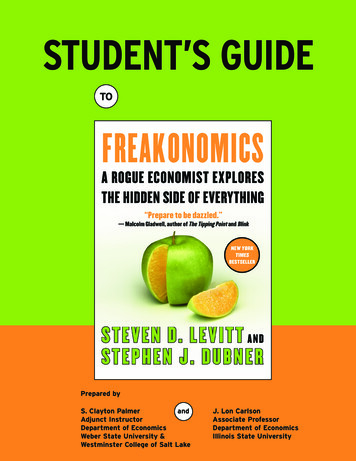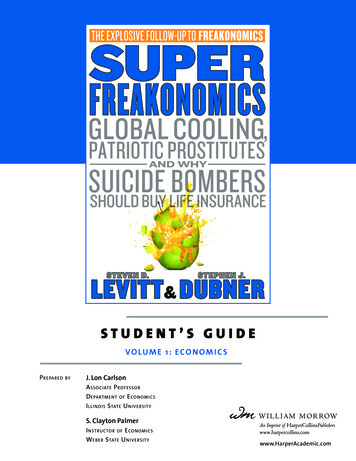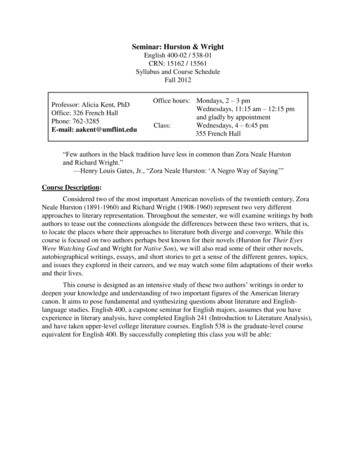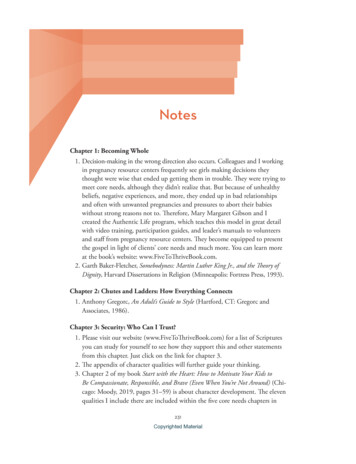
Transcription
STUDENT’S GUIDETOPrepared byS. Clayton PalmerandAdjunct InstructorDepartment of EconomicsWeber State University &Westminster College of Salt LakeJ. Lon CarlsonAssociate ProfessorDepartment of EconomicsIllinois State University
PREFACEIntroductionWelcome to the Student’s Guide to Freakonomics! The purpose of this guide is to help you betterunderstand the analyses presented in Freakonomics by providing a sort of “bridge” between thematerial covered in a traditional course in economic principles and topics addressed in what we consider to be one of the most fascinating books we’ve encountered in economics literature.Many students view economics as a very difficult, if not impossible, course to master.This perceptionis, however, most likely based on observations of the experiences of other students who did not applythe proper approach to learning economics. In many courses, simple memorization is enough.In economics, we would argue, this is not the case.While you need to understand the meaning of basicterms and concepts, you also need to be able to apply economic concepts in specific situations. Inother words, you need to develop the ability to think like an economist.The authors of Freakonomicscertainly show the reader how to do just that.The material presented here is intended to make thejob a little easier.Organization of the Student’s GuideWe organized the material in this guide to help you identify the key points in each chapter andcheck to ensure that you have a firm grasp of the key concepts presented in the book.The firstsection of each chapter in this guide consists of an overview that highlights the major topics andpoints presented in the book.The overview is designed to alert you to the major topics and is notintended to serve, in any way, as a substitute for the material in the text.The second section of each chapter highlights key economic concepts that are addressed in thecorresponding book chapter. In addition, we provide graphical illustrations at various points alongthe way to help you better understand how to use basic economic models to illustrate certainrelationships discussed in the book.The purpose of this discussion is to alert you to the major factorsthat affect the relationship being illustrated. In order to be able to use graphs to analyze the effectsof changes in key economic variables, you must have a clear understanding of how the determinants ofthe relationship being illustrated in a graph are related.The third section of each chapter consists of a list of what we have termed “core competencies.”How well you are able to respond to each of the questions listed in this section will be a strongindicator of the extent to which you understand the material presented in the book.Using the Student GuideWhen using the student guide, remember that the overview and discussions of key graphs and termsare not substitutes for reading Freakonomics. Instead they are designed to “flag” key topics and alertyou to specific items you may have missed.When completing the “core competency” questions, westrongly recommend that you avoid using your book or notes to answer the questions on your initialrun through. Instead, use the questions as a way to flag topics you have not yet mastered.When youcannot answer a specific question, or you answer it incorrectly, you should take that as a signal to goback and devote more study to the topic in question.2
Overview of Freakonomics:Themes and Fundamental IdeasAlthough, as the authors note, there is no single unifying theme the book is built around, we haveidentified a number of concepts that recur throughout the book.Positive vs. Normative AnalysisMany of the tales in Freakonomics are intended to challenge the prior beliefs (i.e., the conventionalwisdom) of the reader.The conclusions derived from various investigations described in each chapterwill often surprise you.They may even irritate your sensitivities.The investigations in these chapters,perhaps like no other quantitatively-oriented book, bring home the differences between looking atthe world from the point of view of a moralist and the world view of a scientist. If morality representsthe way that people would like the world to work, economics represents how it actually does work.According to the authors:“it is well and good to opine or theorize about a subject, as humankind is wont to do, but when moralposturing is replaced by an honest assessment of the data, the result is often a new, surprising insight.”The Nature of Scientific InquiryFreakonomics provides new insights into the scientific process.The investigations in Freakonomicsaddress economic and social issues that are frequently difficult, but not impossible, to quantify.The means of formulating testable hypotheses, the difficulties involved in gathering useful dataand the utilization of those data are testaments to the discipline and creative mental processesof true scientific inquiry.Freakonomics provides concrete illustrations of how unconventional methods of data gathering and“stand-on-your-head” ways of looking at data are often necessary to make sense of the world.Knowing what to measure and how to measure it makes a complicated world less so.Incentives are the cornerstone of modern lifeIndeed, incentives have been the cornerstone of human existence. Economics is the study of humanbehavior as it manifests itself in the sometimes foggy mist of incentives. An understanding of incentivesis the key to clearly understanding any human behavior.The conventional wisdom is often wrongFreakonomics takes pleasure in using the powerful quantitative tools of economic inquiry to turnconventional wisdom on its head.The authors do not argue that conventional wisdom is alwayswrong, but they do conclude that the conventional wisdom that is used as an explanation for manysocial issues is unexamined, unquestioned and often not correct.Dramatic effects often have distant, even subtle, causesAs the authors state: “the answer to a given riddle is not always right in front of you.” Of course,positive economic inquiry and gathering and interpreting the data that are necessary to solve a stickysocial riddle is often hard. But it is the hard part that makes it worthwhile! If it were easy, everyonewould do it.3
Chapter 1 What Do Schoolteachers andSumo Wrestlers Have in Common?SummaryIn this chapter, Levitt and Dubner describe how many people in different cultures and walks of life,who are otherwise inclined to be honest, find subtle ways of cheating to advance their position orincrease monetary awards when incentives are strong enough.The authors define an incentive as “ameans of urging people to do more of a good thing or less of a bad thing,” and identify three varietiesof incentives. Economic incentives are those which a person responds to in the marketplace (broadlyspeaking). Social incentives motivate people to respond in a certain way because they care (or areworried) about how they will be viewed by others (think “Scarlet Letter”). Moral incentives appeal toa person’s sense of right versus wrong.Three case studies of the effects of incentives dominate thechapter; public school teachers in Chicago, sumo wrestling in Japan, and Paul Feldman’s bagel business.The first case considers a group of ordinary people, school teachers, performing an ordinary task,testing their students. Recently, standardized testing has become mandatory in public schools.The NoChild Left Behind law awards schools that make progress on these standardized tests and punishesschools that chronically lag behind. Levitt and a coauthor developed a computer algorithm to look forstrings of suspicious answers on standardized tests. An analysis of data on the test scores of childrenin public schools in the Chicago Public School system reveals evidence that teachers cheat bysubstituting the right answers on students tests in about five percent of classes taught.Sumo wrestling in Japan, which is synonymous with Japanese national pride, is practiced by only themost honorable of men.Yet the analysis described is this chapter provides evidence that a significantnumber of sumo wrestling bouts are actually “rigged” when it really counts.Finally, data collected by Paul Feldman, an entrepreneur who decided to start a bagel business in theWashington, D.C. area shows that people are not above cheating, even when the gain is very low (95cents for a bagel). Even more interesting is the observation that cheating appears to be more likely asthe income level of customers increases.Basic Economic ConceptsIn this section we identify basic economic principles that underlie the analysis presented in this chapter. In addition, we show how basic models economists rely on can be used to help explain some ofthe authors’ conclusions.1. Incentives matter. Incentives, and how people respond to them, is a recurring theme inFreakonomics. Levitt and Dubner claim that:“economists love incentives.The typical economist believes the world has not yet inventeda problem that he cannot fix if given a free hand to design the proper incentive scheme.”In fact, the authors consider the study of incentives to be tantamount to the study of economics.Incentives come in three varieties: moral incentives–by which one acts out of conscience orconviction; social incentives–by which actions are related to shame or glory; and economicincentives–causing people to act in their financial interest.This chapter helps the reader todistinguish among these types of incentives by using an example of a day care center in Haifa,Israel. Once a price is attached to being late to pick up one’s child at a daycare facility, parents4
react in an unexpected way–they show up late more often.The reason is that, before the fine waslevied, most parents picked up their kids on time out of a sense of guilt–a social or moral incentive. Once the fine was levied, parents faced only an economic incentive.This, instead of a sense ofguilt, was now the price for being late. Parents subsequently reassessed the benefits and costs anddecided that the price was worth the extra free time.In this chapter, we also learn that incentives apply in unexpected ways to stalwart members ofthe community. Some teachers face possible sanctions if their students don’t perform well onstandardized tests.They may see cuts in funding for the school, or worse yet, they could losetheir job. So teachers react in a way one would never think a teacher would–they cheat.There is compelling evidence that sumo wrestlers, whose craft is associated directly with honorin Japanese culture, appear to cheat as well.The Freakonomics data in this chapter suggest thata wrestler might throw a match to help his opponent maintain his current ranking.2. Consumer Behavior and Cheating. As a student of economics, you have learned thata consumer’s goal is to maximize utility. How do people accomplish this? Will the ordinary personcheat in order to maximize utility? Apparently so, if the examples in this chapter say anything aboutconsumer behavior. As W.C. Fields once said: “a thing worth having is a thing worth cheating for.”In this chapter we see that cheating takes many forms. Sometimes cheating is the mere withholding,manipulation or distortion of important information. Considering the experiences of PaulFeldman–the bagel entrepreneur—apparently for some people even a bagel is worth cheating for.3. Government Regulation and Unforseen Consequences. As you have undoubtedly learned,the government is sometimes involved in the marketplace. Government involvement in markets canoccur either through taxation or regulation.This chapter illustrates the unintended consequencesof seemingly benign government regulation. Since the implementation of state and federal laws thatrequire “high stakes testing,” i.e., standardized testing with rewards for schools that show improvementand punish schools that don’t, some teachers have invented creative ways to show improvementwithout really adding to the education of their students. According to the data cited in this chapter,35 percent of schoolteacher respondents to a survey in North Carolina said they witnessedtheir colleagues cheating in some fashion.Government policies and regulations, whether federal, state or local are ubiquitous.The reactions ofprivate firms, institutions and individuals to the incentives created by government regulations maybe unintended and unimagined.They may evoke actions that are contrary to the original goal orthey may evoke actions that frustrate a goal of an entirely different government policy or regulation.Core CompetenciesThis chapter raises a rather odd question, “What do Schoolteachers and Sumo Wrestlers have incommon?” Once you have read and carefully studied this chapter you should be able to completethe following tasks which, taken together, answer this and related questions.1. Explain how the imposition of a fine for tardy parents at a day care center may have altered themotivations of these parents.2.What is an incentive? How does it relate to the study of economics?3.What examples can you think of where moral or social incentives and economic incentives are bothpresent? Are the different incentives complementary or competing? For each of the cases you cite,which do you think is the stronger incentive?5
4. Describe some ways in which a school teacher might be able to improve the scores of his or herstudents on a standardized test.5. How has a well motivated and seemingly benign government requirement to administerstandardized tests to grade school students had unintended and malicious consequences?Can you think of other examples of government regulations that were imposed to achieveone goal but have had unanticipated consequences?6. Explain how Levitt devised a means of examining student test scores to uncover evidenceof cheating teachers. Explain also why Levitt’s analysis of the data constituted evidence,but not proof, of cheating.7. Explain what incentives, if any, a university might have to artificially improve the test scoresand grades of its athletes.8. Describe, in general terms, how sumo wrestling tournaments in Japan are arrangedand how the rank of an individual sumo wrestler might change as a result of his performanceat one of these tournaments.9. Describe what it means for a Japanese sumo wrestler to be “on the bubble” and what incentivesthis wrestler and his opponent may have to “throw” a wresting match.10. How did Levitt construct a means of detecting evidence of cheating among Japanese sumowrestlers? What evidence does he offer in support of his claim that some Japanese sumo wrestlersprobably “throw” some of their matches?11. How did Paul Feldman set up his bagel business in the Washington, D.C. area? How did it differfrom most business models?12.What do the authors of Freakonomics conclude from an analysis of the Paul Feldman’s bagel salesdata? Do these conclusions match with economists’ expectations of human behavior?13.What window does an analysis of the sales data of Paul Feldman’s bagel business open? Why is thisusually a difficult subject for economists and others to analyze?14. Based on what can be learned from a study of sales data of Paul Feldman’s bagel business, whatvariables affect the incidence of theft in an office setting?Chapter 2 How Is the Ku Klux KlanLike a Group of Real-Estate Agents?SummaryThis chapter is all about information: the advantages it grants to those who have it, the disadvantages itimposes on those who do not, the ways it can be misused, and the ways it can be abused.The firstpart of the chapter describes how the Ku Klux Klan first came into being and, how, over time, it wasable to exert considerable influence over the lives of those it considered the “enemy,” e.g., blacks, Jews,Catholics.What the discussion also shows very clearly is how the acquisition and dissemination ofinformation that had been known only to members of the Klan–secret coded greetings, the Klan’sorganizational structure–took away much of the power the Klan had previously enjoyed. Once the“secret” was out, much of the membership was no longer willing to participate for fear of beingexposed to the public.6
The remainder of the chapter explores how specific individuals can capitalize on an informationaladvantage by exploiting informational asymmetries, as well as human emotions such as fear andsorrow. Real estate agents have a much better sense of the current condition of local housing marketsthan do buyers and sellers.They can combine this superior knowledge with the buyer’s (seller’s) fearthat he/she won’t be able to find a house (sell his/her house) to achieve a deal which is in the agent’sbest interest but not necessarily the best interests of the buyer or seller.The same can be said offuneral directors, and car salesmen.The chapter also considers the effects of misinformation, e.g.,misrepresentation on corporation balance sheets, and the potentially discriminatory behavior thatcan flow from incorrect or biased information.The chapter concludes with a discussion of themisinformation people post on Internet dating sites, and how voters respond to polls.Basic Economic ConceptsIn this section we identify basic economic principles that underlie the analysis presented in thischapter. In addition, we show how basic models economists rely on can be used to help explainsome of the authors’ conclusions.1.The economic value of information. The model of supply and demand is used to illustrate howthe equilibrium price and quantity of a good or service are determined by the interaction of sellers(supply) and buyers (demand) in a market. One of the underlying assumptions of the model is thatbuyers and sellers have perfect information.Consider Figure 2.1, which illustrates the supply and demand for housing in City A (all houses areassumed to be the same). If buyers and sellers both have perfect information, and all of the otherconditions for a competitive market are satisfied, P1 and Q1 represent the equilibrium price andquantity of houses. However, what if some group of people,say real estate agents, has information other participants inthe market, i.e., buyers and sellers, do not. Consider firstsuppliers. As the authors suggest, real estate agents mayconvince sellers they are better off selling at a lower pricebecause waiting for a better offer might not pay off.To theextent sellers accept this logic, the supply curve shifts tosomething like S2. If, at the same time, agents provideinformation to potential buyers that houses can be had ata lower price than the buyers thought possible, demand isaffected as well.To the extent that buyers revise theirwillingness to pay downward, the demand curve will shift tosomething like D2.The result is that equilibrium price in thehousing market is lower than what it would be if buyers and sellers had perfect information. Notealso that, according to available data, real estate agents who sell their own houses get the price ofP1 rather P2 (because they have the superior information).2. Incentives matter. One of the dominant themes in virtually every economics course is “incentivesmatter.” A rather basic assumption is that buyers and sellers will act so as to make themselves aswell off as possible. Consumers try to maximize total satisfaction, while sellers try to maximizeprofits.This explains why real estate agents don’t work to get the highest price possible for theseller, and why funeral directors sell someone who has just lost a loved one a high-priced casket the7
buyer doesn’t really need. In the first case, selling more quickly makes it easier for the agent to sellmore homes, making more total profit. In the second case, the seller can take advantage of thebuyers’ vulnerability and, in so doing, increase his profits.3.Technological change. Over time, technological change has had profound impacts on our lives,ranging from how the goods we consume are produced, to how we communicate and how wetravel.The list goes on and on.While technological change takes a variety of forms, one thing thatalmost all technological changes have in common is their effect on costs, i.e., costs tend to go down.Consider personal computers. Over the past two decades, the computing power of the typicalhome PC has increased by an astonishing amount. At the same time, the average price of a typicalPC has steadily decreased.This chapter focuses on the effects of technological change in the market for information.With theadvent of the Internet, the cost of both providing and acquiring information has fallen dramaticallyfor almost everyone. One of the effects of this increased availability of information has been to“level the playing field” for consumers of a variety of goods and services.This change is very easy to illustrate graphically. Figure 2.2illustrates the market for information.The curves labeled D1and S1 represent the demand for, and supply of, information,prior to the advent of the Internet. Under those conditions,the equilibrium quantity of information consumed was Q1.After the Internet became readily accessible to the masses,however, the supply ofinformation rose dramatically as illustrated by the shift of thesupply curve to S2. As a result, the equilibrium quantity ofinformation consumed increased to Q2.There is no doubtbut that this increased availability of information has affectedthe market for goods ranging from cars to electronics toreal estate.4. Competition and efficiency. According to the model of supply and demand, so long as certainconditions are satisfied, the market equilibrium ensures that the net benefits from production andconsumption of the good in question are as large as possible. As a result, the outcome is efficient.One of the conditions for an efficient market outcome is that both buyers and sellers have perfectinformation.Thus, the information asymmetry that exists between real estate agents and theirclients suggests that the market outcome will not be efficient. In contrast, with the increased information available via the Internet regarding the prices of different term life insurance policies, theoutcome in that market is more efficient than it was previously.Core CompetenciesThis chapter raises a rather intriguing question, “What do the Ku Klux Klan and Real Estate Agentshave in common?” Once you have read and carefully studied this chapter you should be able to complete the following tasks which, taken together, answer this and related questions.1. Describe, in broad terms, how the Ku Klux Klan came into existence and how its level of popularityvaried over time. In addition, identify specific factors that caused the Klan’s popularity to rise or fall.8
2. Explain Stetson Kennedy’s role in the Klan’s ultimate decline in popularity in the South, focusing onthe role the dissemination of what the Klan believed was secret information played in that process.3. Explain what is meant by the term “information asymmetries” and give examples of informationasymmetries we encounter in everyday life.4. Explain whether, and if so, how, information asymmetries create a competitive advantagefor particular individuals.5. Explain how such innovations as the Internet have affected the prevalenceof information asymmetries.6. Explain how information asymmetries facilitated the corporate scandals that occurredin the early 2000s.7. Provide examples that illustrate how the combination of an information asymmetry and fearcan lead to inefficient outcomes. Explain how the introduction of the element of fear makesthe problem of the information asymmetry even worse.8. What evidence do the authors offer to support their claim that real estate agents exploitan information asymmetry to their client’s detriment? As more clients become aware ofthe possibility of such behavior by agents, how might it affect the relationship between the two?9. Explain how the choice of terms a real estate agent uses to describe a particular property conveysadditional information about the property, and hence the price a potential buyer might be able tosuccessfully offer the seller.10. This chapter examines how the economic incentives of a real estate agent may differ from thoseof his or her client.What other subject matter experts are often hired by individuals and businesses? Might they have incentives that differ from those of the clients that hire them?11. Explain how the information a person has can affect his/her propensity to discriminate.As part of your explanation, distinguish between taste-based discrimination andinformation-based discrimination.12. According to the voting data from the Weakest Link, which two groups of people are most likelyto be discriminated against in that setting.What type of discrimination is being practiced in eachcase? Explain.13. What do the data say about the characteristics of men and women who participate inInternet dating sites relative to the characteristics of the broader population?14. Assuming many of the people who use Internet dating sites are not being truthful when theydescribe themselves, what could motivate them to do so, knowing that if they ever actuallymet a date face-to-face, the truth would likely come out?9
Chapter 3 Why Do Drug DealersStill Live with Their Moms?SummaryOne of the themes of this book is that the conventional wisdom is often wrong. In this chapter, Levittand Dubner quote from the economist and diplomat John Kenneth Galbraith, who asserts that socialbehavior is complex and “to comprehend [its] character is mentally tiring.” So, according to Galbraith,conventional wisdom must be simple, convenient, comfortable and comforting, though not necessarilytrue. Levitt and Dubner cite several examples of conventional wisdom which is demonstrably in error.They go on to note that even though the conventional wisdom may be wrong, it nonetheless may behard to correct. Conventional wisdom is often created by experts in a field.They make observationsand draw conclusions without resorting to the facts.Their conclusions get repeated by the mediaand by other experts who refer to the previously stated error and thus give credibility to it.Repeated often enough, an error can begin to ring true and thus becomes accepted by societyas an unquestionable answer to a tricky social problem.The chapter then goes on to address, and dispel, the conventional wisdom regarding drug dealers, i.e.,they are all rich.They do this by describing how Sudhir Venkatesh, a graduate student in Sociology,acquired detailed financial records from a Chicago “crack” gang.Through these records, a significantamount of information has been compiled on the operations, organizational structure and financialdealings of an extralegal American business. Several economic themes emerge from this chapter’sastounding tale.Many students will find that the tale of the Black Nation Disciples appeals to their voyeuristic nature.This is precisely what is intended. Along this sordid path, students can acquire an understanding of theeconomic concepts described below.Basic Economic ConceptsIn this section we identify basic economic principles that underlie the analysis presented in thischapter. In addition, we show how basic models economists rely on can be used to help explainsome of the authors’ conclusions.1. Fixed and variable costs of production. This chapter provides an intriguing and simpleexample of the costs and revenues of a firm.The revenues of J.T.’s chapter of the Black Disciplescome from the sales of drugs, dues paid to the gang, and extortion. Expenses include the costof the drugs, fees paid to the directors, weapons, mercenary fighters and the salaries of the chapterofficers, dealers and foot soldiers. Let’s consider how J.T.’s costs might vary at different levelsof production. Remember that J.T.’s gang does not manufacture drugs. J.T. is the owner of a retaildistribution business.J.T.s costs are summarized in Table 3.1. First, J.T. has fixed costs. Fixed costs are those short-runcosts which occur regardless of how many crack deals the gang makes on the streets of Chicago.These likely include many of the miscellaneous costs referred to in this chapter: the death benefitsto the families of murdered gang members, legal costs for gang members, bribes to police and government officials, and gang-sponsored community events and the cost of guns.10
Table 3.1J.T.’s Schedule of Costs at Various Levels of ProductionQuantity FixedProduced CostsCostDealers’ Payment Mercenaryof Drugs Wages to Board Fighters 0Total VariableCostsTotalATCMC 0 0 2,700--0 2,700 0 0500 2,700 833 1,584 833 167 3,417 6,117 12.23 6.831,000 2,700 1,667 3,167 1,666 333 6,833 9,533 9.53 6.831,500 2,700 2,500 4,750 2,499 500 10,249 12,949 8.63 6.832,000 2,700 3,333 6,333 3,332 667 13,665 16,365 8.18 6.832,500 2,700 4,167 7,917 4,166 833 17,082 19,782 7.91 6.833,000 2,700 5,000 9,500 5,000 1,000 20,500 23,200 7.73 6.843,500 2,700 5,833 11,082 5,832 1,167 23,914 26,614 7.60 6.834,000 2,700 6,667 12,664 6,664 1,333 27,328 30,028 7.50 6.834,500 2,700 7,500 18,205 7,497 1,916 35,118 37,818 8.40 11.205,000 2,700 8,333 23,745 8,330 2,499 42,908 45,608 9.12 15.58Variable costs include the wholesale cost of purchasing the drugs, wages paid to the street dealers,payments to the gang’s board of directors (remember, these were described as being based ona percentage of sales revenue), and payments to mercenary fighters.The Total Variable Costs columnis the sum of these variable costs. Remember that Total Cost Fixed Cost Variable Costs.Remember also that Average Total Cost (ATC) TC/Q. Finally, the marginal cost column in Table3.1 is calculated as )TC/)Q as one moves from one level of production to the next level. As withthe examples of most businesses you have studied, the ATC curve would exhibit a “U” shape.In addition, the MC curve intersects the ATC curve at the latter’s minimum point.2. A “winne
Freakonomics.Levitt and Dubner claim that: “economists love incentives.The typical economist believes the world has not yet invented a problem that he cannot fix if given a free hand to design the proper incentive scheme.” In fact,the authors consider the study of incentives to be tantamount to the study of economics.










